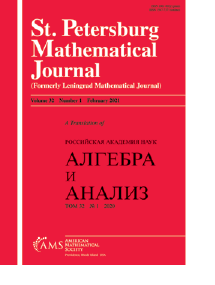Morse index of a cyclic polygon. II
HTML articles powered by AMS MathViewer
- by
A. Zhukova
Translated by: the author - St. Petersburg Math. J. 24 (2013), 461-474
- DOI: https://doi.org/10.1090/S1061-0022-2013-01247-7
- Published electronically: March 21, 2013
- PDF | Request permission
Abstract:
A polygonal linkage can be imagined as a set of $n$ rigid bars connected by links cyclically. This construction lies on a plane and can rotate freely around the links, with allowed self-intersections. On the moduli space of the polygonal linkage, the signed area function $A$ is defined. G. Panina and G. Khimshiashvili proved that cyclic configurations of a polygonal linkage are the critical points of $A$. Later, G. Panina and the author described a way to compute the Morse index of a cyclic configuration of a polygonal linkage. In this paper a simple formula for the Morse index of a cyclic configuration is given. Also, a description is obtained for all possible local extrema of $A$.References
- Jean Cerf, La stratification naturelle des espaces de fonctions différentiables réelles et le théorème de la pseudo-isotopie, Inst. Hautes Études Sci. Publ. Math. 39 (1970), 5–173 (French). MR 292089
- Eka Elerdashvili, Mamuka Jibladze, and Giorgi Khimshiashvili, Cyclic configurations of pentagon linkages, Bull. Georgian Natl. Acad. Sci. (N.S.) 2 (2008), no. 4, 29–32 (English, with English and Georgian summaries). MR 2555487
- M. Farber and D. Schütz, Homology of planar polygon spaces, Geom. Dedicata 125 (2007), 75–92. MR 2322541, DOI 10.1007/s10711-007-9139-7
- C. G. Gibson and P. E. Newstead, On the geometry of the planar $4$-bar mechanism, Acta Appl. Math. 7 (1986), no. 2, 113–135. MR 860287, DOI 10.1007/BF00051348
- G. Khimshiashvili, On configuration spaces of planar pentagons, Zap. Nauchn. Sem. S.-Peterburg. Otdel. Mat. Inst. Steklov. (POMI) 292 (2002), no. Teor. Predst. Din. Sist. Komb. i Algoritm. Metody. 7, 120–129, 179 (English, with English and Russian summaries); English transl., J. Math. Sci. (N.Y.) 126 (2005), no. 2, 1111–1116. MR 1944087, DOI 10.1007/s10958-005-0100-8
- G. Khimshiashvili, Configuration spaces and signature formulas, J. Math. Sci. (N.Y.) 160 (2009), no. 6, 727–736. Algebra and geometry. MR 2760304, DOI 10.1007/s10958-009-9524-x
- G. Panina and G. Khimshiashvili, Cyclic polygons are critical points of area, Zap. Nauchn. Sem. S.-Peterburg. Otdel. Mat. Inst. Steklov. (POMI) 360 (2008), no. Teoriya Predstavleniĭ, Dinamicheskie Sitemy, Kombinatornye Metody. XVI, 238–245, 299 (English, with English and Russian summaries); English transl., J. Math. Sci. (N.Y.) 158 (2009), no. 6, 899–903. MR 2759748, DOI 10.1007/s10958-009-9417-z
- Gaiane Panina and Alena Zhukova, Morse index of a cyclic polygon, Cent. Eur. J. Math. 9 (2011), no. 2, 364–377. MR 2772432, DOI 10.2478/s11533-011-0011-5
- G. Polya, Induction and analogy in mathematics. Mathematics and plausible reasoning, vol. I, Princeton University Press, Princeton, N. J., 1954. MR 0066321
- D. P. Robbins, Areas of polygons inscribed in a circle, Discrete Comput. Geom. 12 (1994), no. 2, 223–236. MR 1283889, DOI 10.1007/BF02574377
- Dimitri Zvonkine, Configuration spaces of hinge constructions, Russian J. Math. Phys. 5 (1997), no. 2, 247–266 (1998). MR 1491636
Bibliographic Information
- A. Zhukova
- Affiliation: Department of Mathematics and Mechanics, St. Petersburg State University, Petrodvorets, St. Petersburg 198904, Russia
- Email: millionnaya13@ya.ru
- Received by editor(s): May 29, 2011
- Published electronically: March 21, 2013
- Additional Notes: Partially supported by the program “Research in Pairs” of Mathematisches Forschungsinstitut Oberwolfach in 2010. The author thanks G. Panina, G. Khimshiashvili, and D. Siersma for their help and useful remarks
- © Copyright 2013 American Mathematical Society
- Journal: St. Petersburg Math. J. 24 (2013), 461-474
- MSC (2010): Primary 14M06; Secondary 53D30, 58E05
- DOI: https://doi.org/10.1090/S1061-0022-2013-01247-7
- MathSciNet review: 3014129


